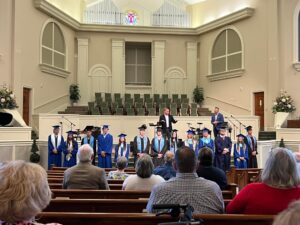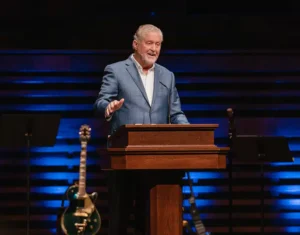
EDITORS’ NOTE: The following reflection on the tragedy at Columbine High School was written by E. Michael Caner, senior pastor of Central Baptist Church, Aurora, Colo., and one of the first counselors on scene April 20, 1999, when 12 students and a teacher were killed and numerous others wounded by two classmates who then killed themselves.
LITTLETON, Colo. (BP)–A decidedly nervous and uncomfortable silence hovers in the air. A group of Columbine High School students with whom I prayed one year ago after the shooting are sitting together in the public park in Littleton, Colo., when one brings up a letter he received that day.
“This national television show is inviting me and three friends to New York for three days to talk about [it]. Anyone up for it?”
If you are familiar with youth-oriented television and entertainment these days, you have seen some teens stand in line all night just to catch a glimpse of themselves on a local show.
Not the students who survived the Columbine tragedy.
One year after the horror which forever changed their childhood, many of these students have developed a common bond — a type of simpatico which even their parents, counselors and teachers do not share.
They have developed an uneasy sense of exploitation which they cannot articulate.
The grief they sense concerning that long afternoon is real. The images of the two young men and the panic which ensued still cause nightmares. The memories of their slain friends still cause tears at school functions.
Yet.
Yet somehow, many of these students have an uneasy sense of frustration concerning the cacophony of media attention which has since surrounded them. One student speaks of not being able to attend an after-school function, because a television team has been following him and his family for a week. Another is frustrated by the sympathetic and almost condescending looks he receives when people find out he was a witness of that day. It is almost, as he says, as if everyone whispers around him, handling him with “kid gloves.”
The resilience of these students is remarkable. Many of the students who will be graduating in just a few weeks have struggled valiantly to reestablish a sense of normalcy in their young lives. They have played on sports teams. They have attempted to have normal school functions. They have tried to maintain those mundane events in their lives which enable people to find closure in tragedy — especially in such young lives. Yet the shadow of the worst event in modern high school history looms large in the background.
One such student goes to great lengths to explain his frustration. “We never forget our [murdered] friends. How could we? Every class I go to reminds me of [them]. What we resent is this spotlight that doesn’t give us a chance to have private lives anymore. I don’t cry in public, because I don’t want a camera shoved in my face.”
The others nod in agreement. There seems to be a sneaking suspicion that they — and the memories of their friends — are being exploited. Every politician has made them a “cause.” Every pundit has referenced them for whatever purpose or lobby they represent. Every media outlet wants to somehow squeeze an exclusive out of this overexposed horror. National figures fly into town, pose for pictures with a few students, exchange uncomfortable pleasantries, and then return home, speaking of their “meetings” with the students with whom they barely spoke.
Their frustration even exists in church. Some of the students speak of holding youth events secretly, so as to avoid the media. One local church has banned cameras in the worship services, as one student noted, because “we couldn’t even worship without some klieg light shining in our eyes.”
The Christian students are a bit less cynical than the others concerning the perceived exploitation, but still noticeably frustrated. Along with their pastors, they were able to proclaim Jesus Christ through this grave adversity, yet they also feel the strain of having to be “on” all the time. The distinction for them is best termed as sanctuary. Their parents, Sunday school teachers and pastors have worked to shield them from the glaring spotlight which has become normative in the past 12 months. They sense that they can be genuine around their church friends, because there is no agenda — no microphones and no sound bites.
Within the confines of their youth groups, they have found the privilege of authenticity. They cry, weep, rage, pray, mourn and hope once again, because their churches have enabled them the luxury which eludes them in public — a sense of privacy. The calm of the prayer closet without having to speak to the multitudes constantly.
One young man even made the astonishing admission that he changed churches after the shooting, because his pastor would not stop inviting him to speak at conferences and other youth groups. He realized the opportunity was important to give other Christian youth courage, but he began to feel like (in his words) part of the disease-of-the-month club, being paraded around for sympathy. He wanted to be heard for his testimony, not just the gruesome details of the tragedy. He wanted to concentrate on sharing the power of God, not just the pain of his loss.
Thus, on this sunny day in the park after school, the students agree — no one is going to the television taping. Enough spotlight. They would like the luxury of grieving in private. To paraphrase my grandmother, these students have old souls … and yet a life to live in front of them.















